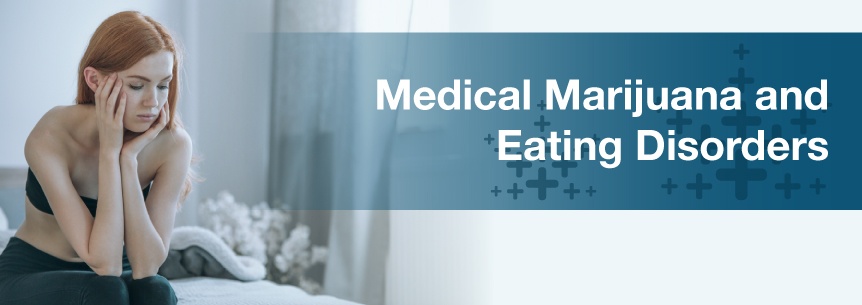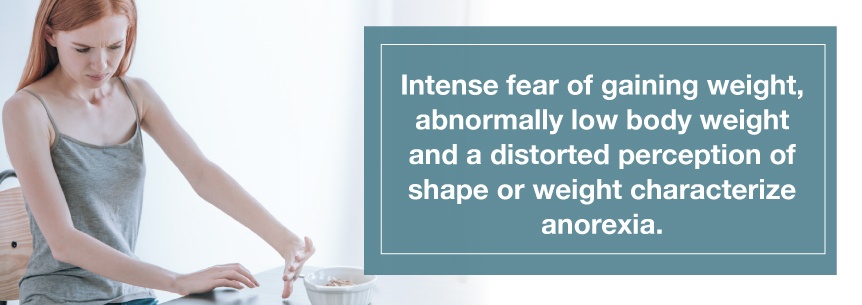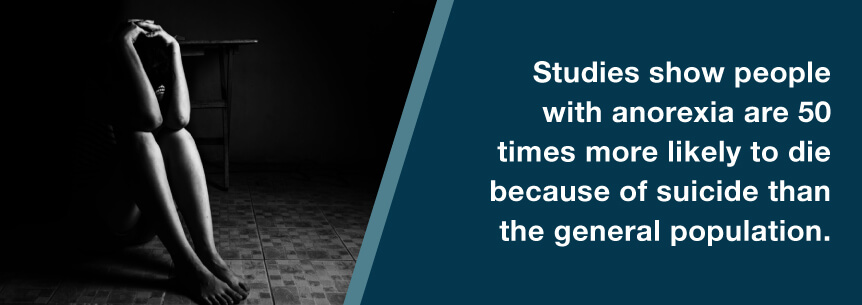
Around 10 million men and 20 million women in the U.S. struggle with an eating disorder in their lifetime, according to the National Eating Disorder Association. Many believe eating disorders are merely a lifestyle choice. However, eating disorders can be hazardous and fatal conditions that severely disturb an individual’s eating behavior. Thankfully, medical marijuana for eating disorders can help.
An eating disorder is a serious illness associated with persistent food-related behaviors that can impact your health, emotions and ability to function in essential areas of life. Three common eating disorders are:
Most eating disorders involve an obsession with your body shape, weight and food, leading to harmful diet-oriented behaviors. These eating behaviors can affect your body’s ability to get proper nutrition.
Among other conditions, an eating disorder can also harm your:
Often, an eating disorder will develop in the teenage and young adult years, but any person of any age can develop an eating disorder. After receiving treatment, however, you can get back to better and healthier eating habits and maybe even reverse some of the serious complications your eating disorder caused.
Eating disorders can impact an individual’s physical and mental health. They can even be life-threatening in some cases. The good news is you can treat eating disorders.
Your symptoms will vary, depending on what type of eating disorder you have.
Symptoms of anorexia may include:
Symptoms of bulimia may include:
Most individuals with a binge-eating disorder are obese or overweight. However, they can also be at a healthy weight. Symptoms of a binge-eating disorder may include:
Unlike an individual with anorexia or bulimia, after you binge, you don’t try and compensate for eating the amount of food you did by vomiting, excessively exercising or using laxatives.
Eating disorders are incredibly complicated conditions, and researchers are continuing to learn more about the causes. While all eating disorders have weight and food issues in common, many experts think eating disorders occur due to individuals trying to cope with painful emotions and overwhelming feelings by controlling food. Sadly, this will eventually harm the person’s physical and emotional health, sense of control and self-esteem.
There are several types of eating disorders, including:
Intense fear of gaining weight, abnormally low body weight and a distorted perception of shape or weight characterize anorexia. It’s potentially life-threatening. Individuals with anorexia go to extreme measures to control their shape and weight, which often interferes with their life activities and health significantly.

With anorexia, you limit calories to the extreme or use other weight-loss methods like:
Efforts to reduce your weight can cause serious health issues, especially when you’re already underweight. Some individuals have gone as far as literally starving themselves to death.
Bulimia is another severe eating disorder that also potentially threatens your life. With bulimia, you go through binge/purge cycles, involving a sense of a lack of control over your eating. A lot of individuals with bulimia restrict their food intake during the daytime, often leading to more binging and purging.
During a binge-and-purge episode, they’ll eat a large amount of food in a short period and then attempt to eliminate the extra calories in an unhealthy manner. Because of shame, guilt or intense fear of overeating-related weight gain, they’ll force vomiting, use laxatives, exercise excessively or try other methods to eliminate the calories.
If you’re struggling with bulimia, chances are you’re preoccupied with your body shape and weight and might be harshly and severely judging yourself for your self-perceived flaws. You might be overweight or at an average weight.
With binge-eating disorder, you’re frequently overeating and feel like you have no control over your food intake. You might eat more food than you wanted — even if you’re not hungry — eat quickly and continue eating, despite feeling uncomfortably full.
You might feel disgusted, guilty or ashamed of your behavior and the amount of food you ate after a binge. However, you don’t try and compensate for this behavior by purging or excessively exercising like someone with anorexia or bulimia would do. You may eat alone to hide your activities out of embarrassment.
People with binge-eating disorder typically will go through a round of binging at least once weekly. You might be overweight, obese or at a healthy weight.
Pica is a newer condition the DSM only recently recognized as an eating disorder. People with pica will crave non-food substances like:
The condition can occur in children, adolescents and adults. However, it’s more common in children, people with mental disabilities and pregnant women.
Avoidant or restrictive food intake disorder, or ARFID, is an old disorder with a new name. Physicians previously called it a “feeding disorder of infancy and early childhood,” and diagnosed it in children under age 7.
While ARFID typically develops in infancy and early childhood, it can continue into adulthood. People with ARFID experience disturbed eating either by not being interested or having a distaste for specific:
Eating disorders cause a wide range of complications, with some of them being life-threatening. The more severe and prolonged the eating disorder is, the higher your risk is of experiencing severe complications like:
Other health complications you could experience are as follows:
People with eating disorders often suffer from depression. For instance, those with anorexia aren’t eating enough food to maintain a healthy body weight, which can lead to tragic results. Studies show people with anorexia are 50 times more likely to die because of suicide than the general population.

Depression can cause eating disorders, but now there’s evidence eating disorders can cause depression. When you’re severely malnourished and underweight, which is quite common in anorexia, it can negatively affect mood states and cause physiological changes.
Individuals who develop an eating disorder don’t feel like they’re good enough. They start obsessing over perfectionism, which causes them to put a lot of focus on what they eat. However, the underlying issue is anxiety and depression.
Facts about eating disorders, according to the National Association of Anorexia Nervosa and Associated Disorders, include:
When it comes to eating disorders, treatment is never easy. Eating disorders, in many cases, can lead to numerous medical problems, requiring forced nourishment, and hospitalization and can even be life-threatening. To bring a person to full recovery from an eating disorder, it can take a multi-disciplinary team of health professionals such as a:
Reducing excessive exercise, obtaining adequate nutrition and stopping purging behaviors are the main focus of treatment. Doctors will tailor the treatment plan based on the patient’s individual needs. Treatment might include one or more of the following treatment options:
Psychotherapies like the Maudsley approach, a family-based therapy where a parent of adolescents with an eating disorder take on the responsibility of feeding their child, seem to be extremely effective in helping patients improve eating habits and moods and gain weight.
To decrease or eliminate purging behaviors and binge eating, individuals might undergo cognitive behavioral therapy, which is another form of psychotherapy that helps individuals learn how to identify unhelpful or distorted thinking patterns and change inaccurate beliefs.
FDA-approved medications like antidepressants, mood stabilizers and antipsychotics might also help treat eating disorders as well as co-occurring conditions like depression and anxiety.
There are side effects of these medications to look out for, including:
Side effects of antipsychotics may include:
Side effects of mood stabilizers may include:
Recently, there’s been significant consolidation and development of evidence for eating disorder psychological therapies. Specific types of family-based treatment and cognitive behavioral therapy have extended and consolidated their positions as preferred treatments, despite the novel approach development. However, there’s still a substantial need for further testing and development to improve recovery rates, especially in anorexia nervosa.
Medical cannabis for eating disorders treats symptoms in a couple of ways.

Research on medical pot as an appetite stimulant for people suffering from HIV/AIDS or cancer has validated the effectiveness of cannabis.
Medical cannabis does have some side effects you should be aware of. Some include:
Medical marijuana and eating disorders treatment can help manage the following symptoms:
Medical pot works best in combination with other treatments and therapies for these particular symptoms.
The following marijuana for eating disorders strains can help ease your symptoms.

While there are numerous methods of consuming medical cannabis for eating disorders, you may be looking for a healthier option. Smoking, while popular, is not the healthiest way of consuming marijuana. Therefore, below are some recommendations for methods that don’t require you to smoke — vaping isn’t the same as smoking.
Now that you know some of the strains and methods of delivery of your cannabis for eating disorders, your next step is to find a certified cannabis doctor to get your medical marijuana card and a dispensary to get your products. Here at MarijuanaDoctors.com, we provide you with both. Use our location finder to consult with a cannabis doctor and find the medical marijuana products you need to begin your medical cannabis treatment.
Find A Doctor Find A Dispensary


Please allow us to access your location to find local dispensaries.
VIEW ALL DISPENSARIES ➔